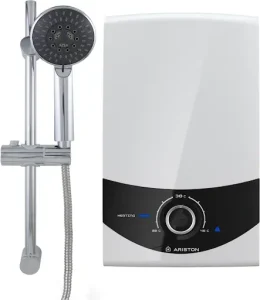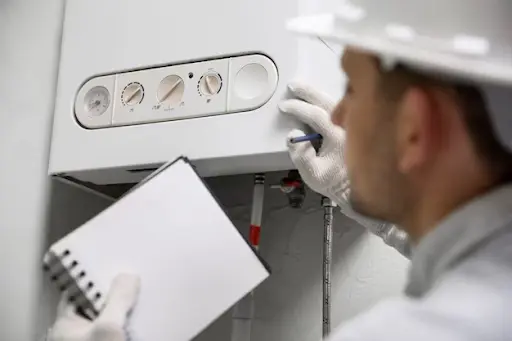Water heaters play a crucial role in the modern household, providing the comfort of hot water for various daily activities. This guide aims to offer a comprehensive understanding of water heaters, covering types, installation procedures, and essential maintenance practices to ensure optimal performance and longevity.
Types of Water Heaters
Tank-Type Water Heaters

Shop the JOVEN JH35 STORAGE WATER HEATER here.
Traditional tank-type water heaters are widely used, and available in different capacities and sizes. They store and heat water in a reservoir, ensuring a steady supply. However, they come with the drawback of standby heat loss.
Tankless (On-Demand) Water Heaters

Shop the Ariston AURES SMART SMC33 here.
Tankless water heaters revolutionize hot water supply by heating water only when needed. Unlike traditional tank-type heaters, they eliminate standby heat loss, ensuring energy efficiency. The compact design saves space and allows flexible installation. With a continuous and unlimited hot water supply, tankless heaters are ideal for larger households.
Professional installation is recommended due to specific requirements. While the initial cost may be higher, the long-term energy savings and modern features make tankless water heaters an efficient and eco-friendly choice for residential water heating.
Heat Pump Water Heaters
Heat pump water heaters utilize ambient heat from the air or ground to warm water, significantly reducing electricity consumption compared to traditional heaters. This environmentally friendly approach aligns with sustainability goals, contributing to energy savings and a reduced carbon footprint.
Effective in moderate climates, they may require additional space for installation and produce some noise during operation. Despite a higher initial cost, the long-term energy savings and potential incentives make heat pump water heaters an attractive investment for environmentally conscious homeowners seeking efficient and sustainable hot water solutions.
Installation Procedures
Pre-Installation Planning
Before installing a water heater, thorough planning is essential. This involves assessing household hot water needs, selecting an appropriate type and size, and determining the location with proper ventilation.
Professional vs. DIY Installation
Choosing between professional and DIY installation of a water heater involves weighing key considerations.
Professional Installation
Certified technicians bring expertise in adhering to codes, and safety standards, and conducting property assessments. They navigate challenges, ensure optimal performance, and often provide warranties, addressing issues promptly.
DIY Installation
While cost-effective, DIY requires a deep understanding of plumbing and electrical work, adherence to guidelines, and the right tools. Homeowners should assess their skills, comfort with potential challenges, and follow safety precautions closely.
The decision hinges on familiarity with installations and the desire for long-term reliability, emphasizing the need for a well-informed choice to ensure efficient and safe water heater operation.
Maintenance Practices
Regular Inspections
Routine inspections are vital to ensure the water heater’s health. Checking for leaks, corrosion, or rust, examining pressure relief valves, and ensuring proper insulation are crucial components of these inspections.
Flushing the Tank
Flushing the water heater tank is a vital maintenance task to preserve efficiency and durability. Sediment buildup over time, especially in hard water areas, can compromise performance.
To flush, turn off the power, connect a hose to the drain valve, and release sediment-laden water. Monitor clarity, close the valve when water runs clear, and restore power. This simple, annual practice ensures consistent hot water, lowers energy bills, and extends the water heater’s lifespan, contributing to ongoing efficiency and reliability.
Temperature Settings and Efficiency Tips
Optimizing temperature settings for safety and efficiency, adjusting thermostat settings, and implementing energy-efficient practices are discussed to enhance the water heater’s performance.
Troubleshooting Common Issues
Inadequate Hot Water Supply
One prevalent issue homeowners encounter is a lack of sufficient hot water. This can be attributed to various factors such as a malfunctioning thermostat, sediment buildup, or issues with the heating element. Troubleshooting involves checking thermostat settings, flushing the tank to remove sediment, or inspecting and potentially replacing the heating element.
Leaks around the Water Heater
Addressing leaks promptly is crucial to prevent damage. Troubleshooting involves identifying the source of the leak, which could be a loose valve, faulty pressure relief valve, or a crack in the tank. Tightening connections, replacing faulty valves, or seeking professional assistance may be necessary, depending on the severity of the leak.
Discolored or Rusty Water
Discolored or rusty water can indicate sediment buildup or corrosion within the tank. Flushing the tank to remove sediment and inspecting the anode rod for corrosion are steps in troubleshooting. Replacing a corroded anode rod can prevent further tank deterioration.
Inconsistent Water Temperature
Issues with inconsistent water temperature may arise from thermostat problems, sediment accumulation, or a malfunctioning heating element. Troubleshooting involves adjusting the thermostat, flushing the tank, and checking the heating element for any faults.
Unusual Noises
Unusual noises, such as banging or popping, can be attributed to sediment buildup at the bottom of the tank. Flushing the tank resolves this issue by eliminating the sediment that causes disturbances during heating cycles.
Pilot Light Malfunctions (Gas Water Heaters)
For gas water heaters, pilot light malfunctions can disrupt the heating process. Troubleshooting includes relighting the pilot light following manufacturer instructions, checking the gas supply, or inspecting the thermocouple for potential issues.
Knowing when to seek professional assistance is crucial, especially for issues like gas leaks, major leaks, or electrical problems that require the expertise of certified technicians. Regular troubleshooting not only maintains a consistent hot water supply but also extends the overall lifespan of the water heater, offering both economic and functional benefits to homeowners.
Elevate Your Bathroom Experience with 360 Bathware – Your Destination for Premium Toilet Solutions
Discover a world of unrivaled quality and style at 360 Bathware, where we redefine your bathroom experience. From cutting-edge designs to superior functionality, our curated collection of toilet bowls and accessories brings a touch of luxury to your space. Transform your bathroom into a haven of comfort and aesthetics with our thoughtfully selected range.
At 360 Bathware, we prioritize your satisfaction, offering a seamless shopping experience backed by top-notch customer service. Ready to enhance every bathroom experience? Reach out to us today for any inquiries!

